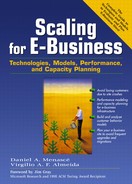2.8. The Customer Visit Model (CVM)
As we discussed in the previous sections, one can obtain the average number of visits to each state of the CBMG from the transition matrix P associated to the CBMG. An alternate and less detailed representation of a session would entail representing a session as a vector of visit ratios to each state of the CBMG. The visit ratio is the number of visits to a state during a session.
Table 2.4 shows an example of three sessions described by the number of visits to each state. Note that states Entry and Exit are not represented in the CVM since the number of visits to these states is always one. Session 1 in the table represents a session of a customer who browsed through the site, did a few searches, but did not login or buy anything. In Session 2, the customer logged in but did not need to register because it was an already registered customer. This customer abandoned the site before paying even though two items had been added to the shopping cart. Finally, Session 3 represents a new customer who registers with the site, adds one item to the shopping cart, and pays for it.
| Session 1 | Session 2 | Session 3 | |
|---|---|---|---|
| Home | 1 | 2 | 3 |
| Browse | 4 | 8 | 4 |
| Search | 5 | 5 | 3 |
| Login | 0 | 1 | 1 |
| Pay | 0 | 0 | 1 |
| Register | 0 | 0 | 1 |
| Add to Cart | 0 | 2 | 1 |
| Select | 3 | 3 | 2 |
The CVM is then a set of vectors (columns in Table 2.4) that indicate the number of times each of the functions supplied by the e-business site are executed. For example, Session 1 would be represented by the vector (1,4, 5, 0, 0, 0, 0, 3) and Session 2 by the vector (2, 8, 5, 1, 0, 0, 2, 3).
Note that the CVM is less detailed than the CBMG in the sense that it does not provide information on the number of times a customer moves from one state to another. Thus, the CVM cannot be used to answer what-if questions of the type illustrated in Ex. 2.4.
Example 2.5
Consider the three sessions of Table 2.4. Assume that each Search request performs an average of three I/Os to the disk containing the index to the catalog of items and that each Select function performs an average of two I/Os to the disk containing the product descriptions. What is the average number of I/Os generated by the three sessions on each of these two disks?
The three sessions perform a total of 13 (=5+5+3) Searches and 8 (=3+3+2) Selects. Thus the average number of I/Os to the index disk is 39 (=13×3) and the average number of I/Os to the catalog disk is 16 (=8× 2).
This example illustrates how the CVM can be used to obtain workload information to be used by the resource model. Chapter 11 discusses these issues in more detail.
